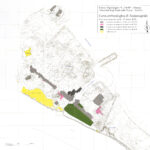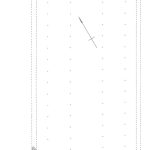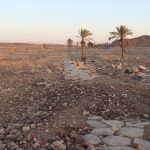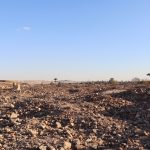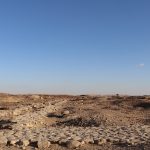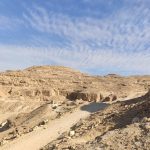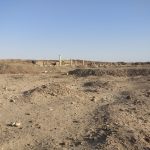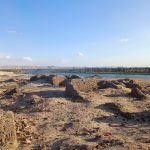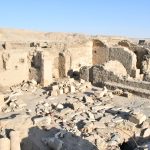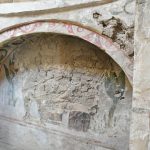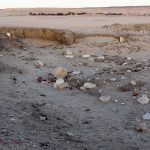AL-ŠAYḪ ʿIBĀDA (ANTINOOUPOLIS)
| Greek | Ἀντινόου πόλις | Νέοι Ἕλληνες |
| Coptic | antinoou | antinwou |
| Arabic | انصنا | الشيخ عبادة |
| English | El-Sheikh 'Abadah | El-Sheikh Ibada | Sheikh 'Abadah | Sheikh 'Ibada | Sheikh Abada | Sheikh Abadah | Sheikh Abbada | Sheikh Ibada |
| French | Antinoé | Antinoë | Cheikh Abada | Cheikh Abadeh | Cheikh Abadèh | Cheikh Ibada |
| German | Scheich Abade |
| DEChriM ID | 23 |
| Trismegistos GeoID | 2774 |
| Pleiades ID | 756518 | PAThs ID | 53 |
| Ancient name | Antinooupolis |
| Modern name | al-Šayḫ ʿIbāda |
| Latitude | 27.808769 |
| Longitude | 30.876365 |
| Date from | 130 |
| Date to | - |
| Typology | City |
| Dating criteria | - |
| Description | The site is located on the east bank of the Nile on a plain which extends from the riverbank to a desert cliff, approximately 10 km north of Mallawī, in the modern district of al-Minyā. The archaeological area lies immediately to the east of the modern village of al-Šayḫ ʿIbāda, which is built over and cover part of the ancient site. The earliest and most conspicuous attestations of a Christian presence in Antinoopolis come from textual sources: a notice in the Historia Ecclesiastica (6.11.2) indicates that Christianity had been established as early as the middle of the III century. Moreover, hagiographic literature confirms that the city was a bishopric by the beginning of the IV century when it was administered by a certain Timotheus (Stewart, 1991). The floruit of the centre is fixed to the fourth-fifth century, when a stable and important monastic activity is documented: Palladius' Historia Lausiaca mentions the existence of 12 nunneries and 1200 hermits present in and scattered around the town; the monastic community was still active in the sixth century, while Coptic texts also refers to places of worship of the relics of the saints Claudius and Colluthus (Stewart 1991; Coquin, Martin, Donadoni, Grossmann 1991). Despite the rich amount of textual information, the preserved archaeological evidence is somewhat dispersed but still rather impressive. The numerous churches mentioned in sources are no longer in existence, but the Italian archaeological missions identified and excavated several buildings in both marginal and central areas of the town (cf. Grossmann 2002, 430-436). In the north cemetery, which dates mostly to the fifth-seventh centuries, a small church complex has been identified, due to newly discovered papyri, as the martyrium of St. Colluthos, a local saint died under the Diocletian Persecution in the early fourth century (Manfredi 1966, 191; 1984, 90; Grossmann 2002, 433-434; 2008c; 2014). As it appears from numerous ex votos found in the area of the church and its attached buildings, the site functioned since the early sixth century also as a sanatorium where incubation rites were carried out. In addition, the large number of small biglietti recovered, containing petitions for assistance in decisions concerning cases of illnesses and other issues, clearly shows that the sanctuary was also an active Christian oracle centre. The architectural arrangement of the sanctuary consisted of a large, roughly rectangular area (C1) surrounded on all sides by thick and originally rather high boundary walls, whose core-structure is represented by the small church located in the northeastern sector, and articulated in a western narthex, a three-aisled nave, and a tripartite sanctuary (Grossmann 2014 figs. 1-2, pls. Ia-b). To the south, on the eastern side of an open courtyard, a series of four small rooms (1-4) was added, serving as incubation chambers; farther to the south, this original complex reached the boundary wall of an earlier built area (A). At a later stage, the area of the sanctuary was enlarged at its western and south-western sides (C2), extending until the already existing complexes D and B, where the entrance to the church area was finally created. Within this expanded area, some small houses (6-8) were then built in the southeastern corner of court C2, while all other units (9, 10) appear as slightly later additions. All these buildings remained in use approximately until the time of the Arab conquest, which apparently mark the end of cult of St. Colluthos. Later on, when the church complex had already been abandoned, a new boundary wall was constructed to surround the whole cemetery area, which ended up cutting through and covering the northern part of the earlier church building since its foundations stand high above the floor level of the church. Within the city, the plan and articulation of the church by the so-called eastern gate can be quite safely reconstructed despite the severe pillaging of the edifice (Uggeri 1974; Grossmann 2002, 430, fig. 52; 2010b, 165-171). It can be dated to the first third of the fifth century, on the basis of the associated pottery assemblage (Grossmann 2010b, 167). Part of the outer wall and the stylobate have been preserved, together with the crypt below the sanctuary, which is the most relevant feature; it was accessible by two symmetrical staircases on both sides of the central chamber, and had on the eastern wall a niche where probably a reliquary was originally placed Grossmann 2002, 430; 2011b, 114-117). Above, at the church level, it appears that the floor of the sanctuary, including the presbytery, consisted of marble slabs (Grossmann 2011b, pls. IIa-b), while limestone was used for the aisles and the western part of the central nave. The presbytery extended even far into the central nave of the church and had at its western margin a large central field (2x2 m) of opus sectile, of which only the bedding layer remains. On the other hand, the apse, which was located to the east of the crypt, has been completely lost so that its size and exact position can only be guessed; it should have run somewhat parallel to the frontal façade of the sanctuary, and from it the lateral pastophoria ‒ if they actually existed ‒ would have been accessible (Grossmann 2010b, 170). To the west of the church an atrium was added at a later stage (Uggeri 1974, 41; Grossmann 2010b, 170-171, pl. Ib, IIIb), and was characterised by square pillar resting on bases with Attic profile and surmounted by Corinthian capitals, as the stone fragments on the ground indicate. Finally, in the western part of the central nave a number of burials have been discovered, consisting of a shaft connected to the burial cave where the body was placed (Grossmann 2010b 169-170, fig. 2; pl. IVa). The deceased were mainly young women, but there were also two men and one child, each one of them having his/her own burial place. The openings into the burial caves were closed with reused stones from the church's walls, and the shafts filled completely with earth, a fact clearly indicating that these burials were excavated after the church was no longer in use, but also that the place maintained religious importance, perhaps because of a connection with an important saint-figure. Moreover, it appears that the area of the sanctuary was not disturbed (with the exception of one tomb), likely out of a sense of respect. Thus, there is the possibility that on special occasions the liturgy was still celebrated in the church (Grossmann 2010b, 170). The church by the east gate is now known to have been attached to a large basilica (labelled as church 2a), which has been identified immediately to the north of the latter, and excavated in recent years (Grossmann 2011b, 111-117; 2011c, 128-133; 2012). The building displays the traditional basilica plan characterised by a large central nave, two lateral aisles, and the sanctuary with semicircular apse and lateral pastophoria. Clearly a later addition to the church is the annex attached to the north-eastern side of the north pastophorium, which had an elaborated entrance on the western side giving access to a main rectangular hall with an apse at the eastern wall. These features, together with the elements of a large peristyle preceding the entrance (only partially investigated), make reasonable to interpret this space as a reception hall possibly belonging to an episcopal palace (episcopium) (Grossmann 2012, 77-82, pls. 2a-b, 3, 4a-b, 5a). The western end of the church is missing, but the remains of a partition wall have been uncovered, which evidently separated the sanctuary on the east from the narthex that was situated on the western part of the edifice. As for the entrance, a certain variation in the width of the northern aisle (as it can be presumed by preserved traces of the original pavement, seems to suggest the presence of a door on this side of the edifice). The basilica was certainly in use as early as the fifth century ‒ this is the date of the complex as indicated by the pottery finds from the adjoining small church ‒, but some elements of the architectural decoration can be assigned to the first half of the sixth century, and probably belong to later additions (Grossmann 2011b, 130, pl. Va-b). Two other church buildings, labelled d2 and d3 and dated to the fifth-sixth centuries, have been identified in the southeastern part of the city, few meters south of the great wadi (Mitchell 1982, 177-178), and fully investigated in recent years: the large building d2 has been identified as the episcopal church of the city, also on account of the presence of a series of rooms on its southeastern side, which include a small apsed chapel and are likely to belong to the episcopal palace of the city (Grossmann 2002, 430-431, fig. 53; 2008b, 227-239; 2009, 257-260). Despite the state of preservation, the spatial articulation of the building has been reconstructed in its essential features (Grossmann 2009, fig. 1): it had a cruciform ground-plan with the sanctuary being composed of a rather large apse flanked by a series of lateral chambers, of which the one adjoining the apse on the right contained a square baptismal font. A second font was located in the northeastern corner of the naos and belonged to the final phase of the edifice. Finally, the western end of the church was marked by a large court-like area serving as the atrium of the building. As for the chronology, the complex is dated to the fifth-sixth centuries. The analysis of the pottery finds sampled in different areas of the excavated church can be indeed assigned to at least three levels of occupation (Guidotti 2018, 81): the first one, dated to the late IV century, was actually associated to an early non-Christian cult building only partially investigated (cf. Grossmann 2009, 260; Guidotti 2008, 64-66, 80-81); the other two belong to the church complex and reflect, respectively, the phase of its construction and first use during the fifth century, and a later, final stage of fifth-sixth centuries. The other church (d3) displays the plan of a regular three-aisled basilica built with a complete series of tall ionic columns reused from an earlier but unknown imperial building (Grossmann 2002, 432-433, fig. 54; 2009, 261-266, fig. 2; 2010a, fig. 1; 2010c, fig. 1; 2011a, 81-85, fig. 1). The usual eastern transverse aisle, here as well as in the nearby church d2, was replaced by a broad fore-choir, while the sanctuary, which is elevated by two steps, consisted of an apse with a slightly wider porch and at least two, large lateral pastophoria. On the other hand, the most distinctive feature of the building marking its functional destination as a Christian healing centre based on incubation rites is represented by the numerous benches (klinai) distributed between the columns and along the lateral walls of the church (Grossmann 2009, pl. IIIa); additionally, a regular series of incubation chambers almost equal in size run along the inner perimeter of the western atrium. From all these elements it can be deduced that the church-complex was dedicate to St. Colluthos. A date to the sixth century has been established for this building, also on the basis of the stylistic analysis of the various preserved elements of its architectural decoration (cf. Severin 2014). Finally, after the Arab conquest, when the complex had been abandoned, a small single-nave church was built in the eastern part of the earlier central nave, the plan of which, however, is no longer understandable in detail (Grossmann 2009, 266-267, fig. 3). It seems that this new building was very modest in size and probably was not provided of lateral aisles. Only the sanctuary has been partially preserved and consists of a central round apse flanked by two rectangular lateral chambers. On the other hand, it remains uncertain whether this church possessed a narthex at its western end. A completely different structure, for type and building technique, is the church located in the south cemetery outside the city (Grossmann 2000; 2002, 434-436, fig. 55). It is a long five-aisled basilica with a three-aisled middle section surrounded on all four sides by a rather narrow passage; with its rows of 22 columns, the edifice features among the longest churches in Egypt known so far. At its western end, the remains of the narthex can be recognised, with a stairwell in its north corner; how the front of the church was originally designed, however, cannot be ascertained. At the opposite, eastern end, there was an old-style sanctuary with a central apse flanked by irregularly shaped lateral rooms on both sides. The apse was decorated by an inner ring of applied columns with two smaller half-rounded entrances to form the sides of the central main opening. On the basis of such distinctive planimetric and architectural features, this church can be safely assigned to the fourth century. The city of Antinoopolis was also served by two cemeteries, placed outside the enclosure wall at the opposite end of the site: the southern one had a pre-Christian origin and was subsequently readapted by the Coptic community and marked by the building of the large early basilica; the northern one was characterised by many mausolea of different size, all built over an earlier necropolis of simple burial pits dug in the ground. Among these monumental structures, one must include the burial chapel of Theodosia, well known for its painted decoration. At the eastern edge of the north necropolis, a large complex has been excavated, with a central court surrounded by a colonnaded portico, which in all probability served as an appropriate area for the celebration of common memorial meals (refrigeria) by the relatives of the deceased who gathered there on regular occasions (Grossmann 2008b, fig. 1). Later, the complex lost his original purpose: the intercolumnia of the western colonnade were partly bricked up to get small chambers provided with independent entrances (Grossmann 2008b, 42). Some of them were also equipped with a staircase leading to an upper floor or to the roof. Apparently, after these transformations, this part of the peristyle-complex was destined to the civilian population as a residential area, while there are no indications yet that this area was inhabited by monks (Grossmann 2008b, 44). From the court of the peristyle, below the floor level, also come some burials. Most of these burials had been disturbed and the bodies were dispersed in the sand; some of theme, however, were still untouched at the moment of the excavations and yielded a large quantity of textiles (Pintaudi 2008, 11-12, figs. 74-94). Overall, the dating materials recovered (mainly coins and papyri) span from the third to the seventh century (Pintaudi 2008b, 12). Angelo Colonna (PAThs project) |
| Archaeological research | The archaeological fieldwork conducted at Antinoopolis has been extensive, and almost continuous since the late 19th century. The first official excavations of the site were initiated in 1895 under the direction of the French Egyptologist Albert Gayet, and continued until 1914. Alongside Gayet, the German philologist and Coptologist Carl Schmidt carried out work in the Christian necropolis in 1896. In 1898, Victor Loret was involved in excavations, and Urbain Bouriant conducted a topographic survey. The relevant publications concerning this fieldwork are extremely limited and of considerably poor quality. In 1910, Ernesto Schiaparelli, the director of the Turin Museum, was granted partial concession for a section of the site. This concession was quickly renounced, and excavations were briefly abandoned. In 1914, John de Monins Johnson of Oxford University initiated further excavations. Like his precursors, the publications were limited, comprising a few articles of narrow scope and a single field report. Eventually, the Istituto Papirologico “G. Vitelli” of Florence began excavating in 1935/6, under the direction of Evaristo Breccia. Sergio Donadoni, from the University La Sapienza, visited the site in 1939, leading to a collaboration between the two teams. After a large hiatus as a result of World War II, the two teams shared the concession from the mid-60s onwards, almost without interruption. Between 1993 and 2000, all field-work opportunities were restricted due to security measures which resulted in the closure of Middle Egypt. In 2000, the Istituto Papirologico “G. Vitelli” of Florence began work again, under the direction of Rosario Pintaudi. Since 2023, the Italian mission is directed by Francesca Maltomini. |
• Abdal-Tawab, A.-R., M. Ghattas and P. Grossmann. 2001. “Preliminary Report on the Excavation of a Monastic Complex to the South of Antinoopolis.” Bulletin de la Société d’archéologie copte 40: 35-52.
• Adriani, A. 1939. “Scavi della missione dell’Istituto Papirologico Fiorentino ad Antinoe.” Annales du Service des antiquités de l’Égypte 39: 659-663.
• Alphandéry, P. 1903. “Les fouilles de M. Gayet à Antinoë.” Revue de l’histoire des religions 47, 1: 433-435.
• Arrigoni, E. 1982. “Locus ex machina e neo-divinità Antinoo; topografia antinopolitana in Egitto e sua geminazione nella «Besantìnoe» d’Attica.” Quaderni ticinesi. Numismatica e antichità classiche 11: 215-254.
• Awad Rayed, F. and H. Kellawy. 2021. “New Inscribed Stones from Antinoupolis.” Analecta Papyrologica 23: 289-295.
• Baldassare, I. 1988. “Alcune riflessioni sull’urbanistica di Antinoe (Egitto).” Annales du Service des antiquités de l’Égypte 49: 157-166.
• Baldassare, I. and I. Bragantini. 1983. “Antinoe - necropoli meridionale (saggi 1978): Relazione preliminare; III Materiali ceramici.” Annales du Service des antiquités de l’Égypte 49: 157-161 and 161-166.
• Ballet, P. 2008. “D’Alexandrie à Antinoopolis. Fondations égyptiennes et réseau viaire.” In La rue dans l’antiquité. Définition, aménagement, devenir, edited by P. Balllet, N. Dieudonné-Glad and C. Saliou, 151-160. Rennes: Presses universitaires de Rennes.
• Ballet, P. and M. Cristina Guidotti. 2014. “Identificazione e analisi delle discariche domestiche e industrialia della città di Antinoe.” In Antinoupolis I, edited by R. Pintaudi and G. Bastianini, 165-222. Florence: Istituto Papirologico “G. Vitelli”.
• Bailey, D. M. 1999. “A Ghost Palaestra at Antinoopolis.” Journal of Egyptian Archaeology 85: 235-9.
• Baillet, J. 1907. Les tapisseries d’Antinoé au Musée d’Orléans. Orléans: Pigelet & Fils.
• Ballet. Pascale. 2008. “D’Alexandrie à antinoopolis. Foundations égyptiennes et réseau viaire.” In La rue dans l’antiquité. Définition, aménagement, devenir, edited by P. Ballet, N. Dieudonné-Glad, and C. Saliou, 151-60. Rennes: Presses universitaires de Rennes.
• Bartoletti, V. “La Madonna con il Bambino in un Papiro Copto di Antinoe.” In Studi in onore di Luisa Banti, 29-31 and plate X. Rome: "L'Erma" di Bretschneider.
• Barns, J. and H. Zilliachus. 1960/1967. The Antinoopolis Papyri, Part. II and III. London: Egypt Exploration Society.
• Bastianini, G. 2012. “Un codice dell’Iliade da Antinoe: PSI XIII 1298.” In I papiri omerici: atti del convegno internazionale di studi: Firenze, 9-10 giugno 2011 (Studi e Testi di Papirologia, N.S. 14), edited by G. Bastianini and A. Casanova, 279-292. Florence: Istituto Papirologico «G. Vitelli».
• Bastianini, G. and R. Pintaudi. 2017. “Due documenti con Aurelio Teofilo economo del martyrium di San Colluto.” In Antinoupolis III, edited by R. Pintaudi, 593-622. Florence: Florence University Press.
• Bell, H. I. 1933. “Diplomata Antinoitica.” Aegyptus 13: 514-528.
• Bell, H. I. 1940. “Antinoopolis: A Hadrianic Foundation in Egypt.” Journal of Roman Studies 30, 2: 133-147.
• Bénazeth, D. 1992. Musée du Louvre: L’art du métal au début de l’ère chrétienne. Paris: Ministère de la Culture, Éditions de la Réunion des Musées Nationaux.
• Bénazeth, D. 2004. “Les tissus “sassanides” d’Antinoé au Musée du Louvre.” In Riding Costume in Egypte. Origin Appearance, edited by C. Fluck, G. Vogelsang-Eastwood, 117-128. Boston: Brill.
• Bénazeth, D. 2006. “From Thais to Thaias: Reconsidering Her Burial in Antinoopolis (Egypt).” In Textiles in Situ. Their Find Spots in Egypt and Neighbouring Countries in the First Millennium CE, edited by S. Schrenk, 69-83. Riggisberg: Abegg-Stiftung.
• Bénazeth, D. 2007. “Essai de datation par la méthode du radiocarbone de vêtements à la mode orientale retrouvés à Antinoé et de quelques soieries apparentées.” In Methods of Dating Textiles from the 1st Millennium from Egypt and Neighbouring Countries. Proceedings of the 4th Meeting of the Study Group “Textiles in the Nile Valley.” Antwerp, 6-7 October 2007. Tielt: Lannoo Publishers.
• Bénazeth, D. and C. Fluck. 2004. “Fussbekleidung der Reitertracht aus Antinoopolis in Überblick.” In Riding Costume in Egypte. Origin and Appearance, edited by C. Fluck, G. Vogelsand-Eastwood, 189-205. Boston: Brill.
• Bénazeth, D. and M. Van Strydonck. 2006. “Carbone 14 et archéologie copte: la sépulture de Thaïas à Antinoé.” In Études Coptes IX: Onzième journée d’études, Strasbourg, 12-14 juin 2003, edited by A. Boud’hors, J. Gascou and D. Vaillancourt, 45-66. Paris: E. de Boccard.
• Bernand, A. 1984. Les portes du désert. Recueil des inscriptions grecques d’Antinooupolis, Tentyris, Koptos, Apollonopolis Parva et Apollonopolis Magna. Paris: Éditions du Centre national de la recherche scientifique.
• Bingen, J. 1977. “Une dédicace augustéenne sur le site d’Aninoé.” Zeitschrift für Papyrologie und Epigraphik 24: 245.
• Bingen, J. 1984. “Épigraphie grecque et latine: d’Antinoé à Edfou.” Chronique d’Égypte 59, 188: 359-370.
• Bingen, J. 1988. “Un premier volume de papyrus Wessely Pragenses.” Chronique d’Égypte 63, 126: 379-389.
• Boak, A. E. R. 1927. “The Epikrisis Record of an Ephebe of Antinoopolis Found at Karanis.” Journal of Egyptian Archaeology 13: 151-154.
• Bongrani-Fanfoni, L. 1974. “Scavi nell’area del tempio ramesside, 1966.” In Antinoe (1965-1968) Missione Archeologica in Egitto dell’Università di Roma, edited by S. Donadoni, 33-36, fig. 13 and pl. XI to XVII. Rome: Istituto di studi del Vicino oriente.
• Bonnet, E. 1902. “Plantes antiques des nécropoles d’Antinoé.” Journal de botanique 16, (9 September): 314-319.
• Borgia, E. 2017. “Sigillate locali e di importazione ad Antinoupolis: un primo bilancio dal materiale erratico.” In Antinoupolis III, edited by R. Pintaudi, 113-206. Florence: Florence University Press.
• Borgia, E. 2019. “Aswan Thin-Walled Figure Painted Bowls from Antinoupolis”. Analecta Papyrologica 31: 249-260.
• Borgia, E. 2021. “Su un orecchino in bronzo di epoca proto-bizantina da Antinoupolis”. Analecta Papyrologica 33: 325-326.
• Borgia, E. and M. Elefante. 2022. “Un eulogion di San Phoibammon da Antinoupolis.” Analecta Papyrologica 34: 7-16.
• Borrini, M and P. Paolo Mariani. 2017. “La sepultura di Teodosia: l’archeologia e l’antropologia forense come strumenti d’identificazione nel caso di una sepultura a camera dal sito di Sheikh ‘Abadah (Antinoupolis).” Antinoupolis III, edited by R. Pintaudi, 375-414. Florence: Florence University Press.
• Braunert, H. 1962. “Griechische und Römische Komponenten im Stadtrecht von Antinoopolis.” Journal of Juristic Papyrology 14: 73-88.
• Breccia, E. and S. Donadoni. “Le prime ricerche italiane ad Antinoe (Scavi dell’Istituto papirologico fiorentino negli anni 1936/1937; gli Scavi del 1938).” Aegyptus 18, 3 (July/December): 285-318.
• Brunel, C. 2002. "D’Antinoopolis à Samarobriva. Couleurs du Nil en Pays de Somme. La Collection de Tissues Coptes du Musée de Picardie." Masters Thesis. Université de Picardie, Amiens (unpublished).
• Cadell, H. 1965. “P. Caire Ifao inv. 45, P. Oxy. XIV 1719 et les privilèges des antinoïtes.” Chronique d’Égypte 40, 80 (July): 357-363.
• Calament, F. 1989. “Antinoë: Histoire d’une collection dispersée.” Revue du Louvre et des musées de France 5, 6 (December): 336-342.
• Calament, F. 1997a. “Antinoé dans les collections.” In Guide du visiteur. Les antiquités égyptiennes II. Égypte romaine, art funéraire, antiquités coptes, éd. Réunion des Musées Nationaux: 17-23.
• Calament, F. 1997b. “Antinoé revisitée: Portrait d’un archéologue de circonstances.” Archéologia 226 (September): 60-67.
• Calament, F. 2004. L’apport historique des découvertes d’Antinoé au costume dit de “cavalier sassanide”.” In Riding Costume in Egypt. Origin and Appeareance, edited by C. Fluck and G. Vogelsang-Eastwood, 37-72. Boston: Brill.
• Calament, F. 2005. La révélation d’Antinoé par Albert Gayet. Histoire, archéologie, muséographie. 2 vols. Cairo: IFAO.
• Calament, F. 2007. “Les amphores en contexte funéraire à Antinoé.” Cahiers de la céramique égyptienne 8: 727-735.
• Calament, F, M.-H. Rutschowascaya and M. Schœfer. 1994. “La collection de tissus coptes d’Antinoé: Problèmes de dispersion et exemple d’intervention.” In Journées d’études de la SFIC. La conservation des textiles anciens, Angers, 20–22 oct. 1994, 207-225. Dijon: International Institute for Conservation of Historic and Artistic Works Section Française.
• Calament, F., R. Eichmann and C. Vendries. 2012. Le luth dans l’Égypte byzantine. La tombe de la “Prophétesse d’Antinoé” au musée de Grenoble. Rahden: Marie Leidorf.
• Calandra, E. 2008. “La città e il nome: progetto politico e utopia nella fondazione di Antinoe”. In Utopia e utopie nel pensiero storico antico, edited by C. Carsana and M. T. Schettino, 133-159. Roma: "L'Erma" di Bretschneider.
• Capart, J. 1945. “Antinoé: fouilles del’Université de Florence (1940).” Chronique d’Égypte 20, 39 (January): 100-101.
• Careddu, G. 2001. “Antinoe: temi figurativi nei tessuti copti del Museo civico d’arte antica di Torino.” Bollettino della Società piemontese di archeologia e belle arti, n.s., 53: 73-79.
• Castellucci, P. 2017. “Frammenti sporadici di pietre ornamentali da Antinoupolis.” In Antinoupolis III, edited by R. Pintaudi, 277-308. Florence: Florence University Press.
• Castrizio, D. 2008a. “Le monete “bizantine” dalla necropoli nord di Antinoe (1979-2006) e la serie a leggenda PAN. Relazione preliminare.” In Antinoupoulis I, edited by R. Pintaudi, 217-278. Florence: Istituto Papirologico “G. Vitelli”.
• Castrizio, D. 2008b. “Per un’interpretazione del papiro figurato da Antinoe.” In Antinoupolis I, edited by R. Pintaudi and G. Bastianini, 107-110. Florence: Istituto Papirologico “G. Vitelli”.
• Castrizio, D. 2008c. “Il tesoretto aureo dal complesso del santuario di San Colluto della necropoli nord di Antinoe.” In Antinoupolis I, edited by R. Pintaudi and G. Bastianini, 229-278. Florence: Istituto Papirologico “G. Vitelli”.
• Castrizio, D. 2010. Le monete della necropoli nord di Antinoupolis (1937-2007). Florence: Istituto Papirologico “G. Vitelli”.
• Castrizio, D. 2017a. “L’iconografia del “Cristo ricciuto”.” In Antinoupolis III, edited by R. Pintaudi, 207-210. Florence: Florence University Press.
• Castrizio, D., R. Pintaudi and A. Soldati. 2017. “Un episodio del conflitto con i blemmi (?), raffigurato in una stanza dell’area del martyrium di San Colluto.” In Antinoupolis III, edited by R. Pintaudi, 415-458. Florence: Florence University Press.
• Cauderlier, P. 1978. “Sciences pures et sciences appliquées en Égypte romaine: Essai d’inventaire antinoïte.” In Recherches sur les artes à Rome. Dijon: Publications de l’Université de Dijon: 52-57.
• Chassaigne de Nérondes, A. 1905. “Le théâtre aux fouilles d’Antinoë. Khelmis, la précieuse chanteuse.” La revue théâtrale 2 (July).
• Clermont-Ganneua, C. 1903. “Inscriptions grecques d’Antinoé.” Recueil d’archéologie orientale 5, 24 (August): 371-372.
• Coli, M., G. Pini and G. Rosati. 2008. “I siti estrattivi di Antinoe.” In Antinoupolis I, edited by R. Pintaudi and G. Bastianini, 509-532. Florence: Istituto Papirologico “G. Vitelli”.
• Coli, M., G. Rosati and M. Baldi. 2014. “La Via Adriana ad est di Antinoupolis: esplorazione e rilievi.” In Antinoupolis II, edited by R. Pintaudi, 359-375. Florence: Florence University Press.
• Coppola, M. and G. Rosati. 2014. “Il tempio di Ramesse II ad Antinoe.” In Antinoupolis II, edited by R. Pintaudi, 121-152. Florence: Florence University Press.
• Coquin, R.-G., M. Martin, S. Donadoni and P. Grossmann. 1991. “Antinoopolis.” In The Coptic Encyclopedia, edited by A.S. Atiya, 144-148. New York: Macmillan.
• Corcoran, S. 2007. “Two Tales, Two Cities: Antinoupolis and Nottingham”. In Wolf Liebeschuetz Reflected: Essays Presented by Colleagues, Friends, and Pupils (Bulletin of the Institute of Classical Studies. Supplement 91), edited by J.F. Drinkwater and B. Salway, 193-209. London: Institute of Classical Studies, School of Advanced Study, University of London.
• Crisci, I. 1974. “Iscrizioni greche.” In Antinoe (1965-1968) Missione archeologica in Egitto dell’Università di Roma, edited by S. Donadoni, 119-124 and pl. LIV to LVI, Rome: Istituto di studi del Vicino oriente.
• Crum, W. E. 1901. “Two Coptic Papyri from Antinoe.” Proceedings of the Society of Biblical Archaeology 26, 197 (May): 174-178.
• Daciert, É. 1902. “Bibliographie. Antinoé et les sépultures de Thaïs et de Sérapion, par Al. Gayet.” Revue de l’art ancien et moderne 13, 71 (février): 159-160.
• Decker, W. 1974. “Bemerkungen zum Agon für Antinoos in Antinoupolis (Antinoeia).” Kölner Beiträge zur Sportwissenschaft 2: 38-56.
• Delattre, A. 2008. “Textes coptes et grecs d’Antinoé.” In Antinoupolis I, edited by R. Pintaudi and G. Bastianini, 131-162. Florence: Istituto Papirologico “G. Vitelli”.
• Delattre, A. 2014. “Annexe. Les inscriptions.” In Antinoupolis II, edited by R. Pintaudi, 355-358. Florence: Florence University Press.
• Delattre, A. 2017a. “Inscription copte d’une colonne de l’église D3 à Antinoé.” In Antinoupolis III, edited by R. Pintaudi, 489-492. Florence: Florence University Press.
• Delattre, A. 2017b. “Minima epigraphica.” In Antinoupolis III, edited by R. Pintaudi, 493-508. Florence: Florence University Press.
• Delattre, A. 2017c. “Des formules épistolaires et une citation biblique sur un ostracon d’Antinoé.” In Antinoupolis III, edited by R. Pintaudi, 647-650. Florence: Florence University Press.
• Delattre, A. 2017d. “Trois billets oraculaires.” In Antinoupolis III, edited by R. Pintaudi, 651-654. Florence: Florence University Press.
• Delattre, A. 2017e. “Liste de noms.” In Antinoupolis III, edited by R. Pintaudi, 655-656. Florence: Florence University Press.
• Delattre, A. 2017f. “Compte copte tardif et exercices d’écriture en copte et en arabe sur parchemin.” In Antinoupolis III, edited by R. Pintaudi, 657-664. Florence: Florence University Press.
• Delattre, A. 2017g. “Deux inscriptions funéraires coptes.” In Antinoupolis III, edited by R. Pintaudi, 715-718. Florence: Florence University Press.
• Delattre, A. and R. Pintaudi. 2017. “Une pièce de cuir trouvée à Antinoé.” In Antinoupolis III, edited by R. Pintaudi, 723-726. Florence: Florence University Press.
• Delattre, A., R. Pintaudi and N. Vanthieghem. 2017. “Les archives de Paule, fils de Petros, de la Rue du Sauveur.” In Antinoupolis III, edited by R. Pintaudi, 623-634. Florence: Florence University Press.
• Del Corso, L. 2015. “Osservazioni sulla datazione di alcuni frammenti di codici da Antinoupolis”. In Scritti paleografici e papirologici in memoria di Paolo Radiciotti (Supplemento a «Papyrologica Lupiensia» 24/2015), edited by M. Capasso and M. De Nonno, 167-192. Lecce: Pensa MultiMedia Editore.
• Del Corso, L. 2017. “Per un corpus delle iscrizioni greche da Antinoupolis (con due esemplificazioni).” In Antinoupolis III, edited by R. Pintaudi, 665-674. Florence: Florence University Press.
• Del Corso, L. and R. Pintaudi. 2017a. “Testi scolastici e grammaticali.” In Antinoupolis III, edited by R. Pintaudi, 541-562. Florence: Florence University Press.
• Del Corso, L. and R. Pintaudi. 2017b. “Ostrakon (?) con ἄτρητος.” In Antinoupolis III, edited by R. Pintaudi, 563-565. Florence: Florence University Press.• Del Francia Barocas, Loretta. 1984. “Tissus coptes d’Antinoé à Florence.” Rivista degli studi orientali 58, fasc. 1-4: 55-83.
• Del Francia Barocas, L. ed. 1987. Studi in onore di Ugo Monneret de Villard. I. La valle del Nilo in epoca cristiana. Rome: Bardi.
• Del Francia Barocas, L. 1998. Antinoe cent’anni dopo. Catalogo della mostra Firenze, Palazzo Medici Riccardi 10 luglio - 1 novembre 1998. Florence: Istituto Papirologico “G. Vitelli.”.
• Del Franca Barocas, L. 2007. “Antinoupolis et Panopolis. Nouvelles hypothèses sur la datation de quelques tissus.” In Actes du huitième international d'études coptes (Paris, 28 Juin-3 Juillet 2004), edited by N. Bosson and A. Boud’hors, 147-160. Paris & Leuven: Peeters.
• Donadoni, S. 1938. “Notizia sugli scavi della missione fiorentina ad Antinoe.” Annales du Service des antiquités de l’Égypte 38: 493-501 and pl. XCII to XCIII.
• Donadoni, S. 1939. “Rapporto preliminare degli scavi della missione fiorentina nel tempio di Ramesse II ad Antinoe.” Annales du Service des antiquités de l’Égypte 39: 665-677 and pl. CXXII to CXXV.
• Donadoni, S. 1940. “Rapporto preliminare della campagna di scavo ad Antinoe della missione fiorentina, 1940.” Annales du Service des antiquités de l’Égypte 40: 715-720.
• Donadoni, S. 1945. “Stoffe decorate da Antinoe.” In Scritti dedicati alla memoria di Ippolito Rosellini nel primo centenario della morte (4 giugno 1943), 109-155 and pl. XIX to XXIV. Florence: Felice Le Monnier.
• Donadoni, S. 1945. “I lavori della missione fiorentina al tempio di Ramessese II ad Antinoe.” In Scritti dedicati alla memoria di Ippolito Rosellini nel primo centenario della morte (4 giugno 1943), 171-190 and pl. XXXI to XXXII. Florence: Felice Le Monnier.
• Donadoni, S. 1954. “Una domanda oracolare cristiana da Antinoe.” Rivista degli studi orientali 29: 183-186.
• Donadoni, S. 1957. “Epigrafia cristiana minore da Antinoe.” In Studi in onore di Aristide Calderini e Roberto Paribeni II. Studi di papirologia e antichità orientali, 479-489. Milan: Ceschina.
• Donadoni, S. 1966. “Pro memoria sui kimân di Antinoe.” Oriens antiquus. Rivista del Centro per le antichità e la storia dell’arte del Vicino oriente 5, 2: 277-293 and pl. LXVII to LXXI.
• Donadoni, S. 1968. “Due lettere copte da Antinoe.” Journal of Egyptian Archaeology 44 (August): 239-242.
• Donadoni, S. 1970. “Una necropoli protodinastica ad Antinoe.” In Actes du VIIe Congre?s international des sciences pre?historiques et protohistoriques, Prague, 21-27 aou?t 1966, edited by Jan Filip, 224-227. Prague: Academia.
• Donadoni, S. 1974a. “Alcune case a est del tempio ramesside, 1967.” In Antinoe (1965-1968) Missione Archeologica in Egitto dell’Università di Roma, edited by S. Donadoni, 133-140, fig. 67-69 and pl. LXII to LXVII. Rome: Istituto di studi del Vicino oriente.
• Donadoni, S. 1974b. “La necropoli meridionale (1968).” In Antinoe (1965-1968) Missione Archeologica in Egitto dell’Università di Roma, edited by S. Donadoni, 141-155, fig. 70 and pl. LXVIII to LXXXIII. Rome: Istituto di studi del Vicino oriente.
• Donadoni, S. 1982. “Fouilles de l’Université de Rome à Antinoé, Thèbes et au Sudan.” Bulletin de la Société d’égyptologie de Genève 7: 11-12.
• Donadoni, S. 19993. “Una statua reimpiegata da Remesse II ad Antinoe.” In Hommages à Jean Leclant, edited by C. Berger, G. Clerc and N. Grimal, 449-453. Cairo: Institut français d'archéologie orientale.
• Donadoni, S. et. al. 1974c. Antinoe (1965-1968) Missione Archeologica in Egitto dell’Università di Roma. Rome: Istituto di studi del Vicino oriente.
• Donadoni, S. s.v. 1975. “Antinooupolis.” In Lexikon der Ägyptologie 1, col. 323-325.
• Emmel, S. and K. Hacken South. 1996. “Isaac of Antinoopolis, Encomium on Colluthus for 24 Pasons (19 May). A New Identified Coptic Witness (Brit. Libr. Or. 7558 [40] = Layton, Cat. BLC, No. 146.” Analecta Bollandiana 114: 5-9.
• Elefante, M. 2020. “Manufatti ceramici tra religione e mercato: le ampolle di San Mena. Due esempi da Antinoupolis.” In Atti LIII Convegno Internazionale della Ceramica 2020. Ceramica per i complessi religiosi e i luoghi di assistenza e misericordia: committenza, produzione e consumo», Savona: Borgo San Lorenzo, 9-10 ottobre 2020, 7-17. Florence: All’Insegna del Giglio.
• Elefante, M. 2021. “I vasi da noria in Egitto. Il caso di Antinoupolis.” Vicino Oriente 25: 195-212.
• Euting, J. 1896. “Hebräische Inschrift aus Antinoë.” Zeitschrift für Ägyptische Sprache und Altertumskunde 34: 164-165.
• Fabre, M. 2001. Rapport de restauration du cartonnage égyptien de la momie d’Antinoé du musée d’Art et d’Histoire naturelle de Châteaudun, 24 avril 2001 (unpublished).
• Fluck, C. 2004. “Zwei Reiterminäntel aus Antinoopolis im Museum für Byzantinische Kunst, Berlin. Fundkontext un Beschreibung.” In Riding Costume in Egypt. Origin and Appearance, edited by C. Fluck and G. Vogelsang-Eastwood, 137-152. Leiden: Brill.
• Fluck, C. and H. F. 2011. “Dress Accessories from Antinoupolis. Finds from the Northern Necropolis.” In Dress Accessories of the 1st Millennium AD from Egypt. Proceedings of the 6th Conference of the Research Group “Textiles from the Nile Valley.” Antwerp, 2-3 October 2009, edited by A. De Moor and C. Fluck, 54-69. Tielt: Lannoo Publishers.
• Fluck, C., P. Linschield and S. Merz. 2000. Staatliche Museen zu Berlin – Preußischer Kulturbesits Skulpturensammlung und Museum für Byzantinische Kunst, Bestamdskataloge. I. Textilien aus dem Vorbesitz von Theodor Graf, Carl Schmidt und dem Ägyptischen Museum Berlin. Wiesbaden: Reichert Verlag.
• Fluck, C. and G. Vogelsang-Eastwood. eds. 2004. Riding Costume in Egypt. Origin and Appearance. Leiden: Brill.
• Fournet, J.-L. and D. Pieri. 2008. “Les dipinti amphoriques d’Antinoopolis.” In Antinoupolis I, edited by R. Pintaudi and G. Bastianini, 175-216. Florence: Istituto Papirologico “G. Vitelli”.
• Fournet J., 2009. “I papiri di Antinooupolis: la collezione e gli scavi fiorentini.” In 100 anni di istituzioni fiorentine per la papirologia: 1908, Società Italiana per la ricerca di Papiri, 1928, Istituto Papirologico «G. Vitelli»: atti del convegno internazionale di studi Firenze, 12-13 giugno 2008, Studi e Testi di Papirologia N.S. 11, edited by G. Bastianini and A. Casanova, 115-132. Florence: Istituto Papirologico «G. Vitelli».
• Froschauer, H. 2008. “Antinoupolis. Erster Vorbericht zu den Textilfunden aus der Nekropole Nord (Grabungskampagnen Frühjahr und Herbst 2007)”. Analecta Papyrologica 18-20: 269-274.
• Gasiorowski, S. J. 1931. “A Fragment of a Greek Illustrate Papyrus from Antinoë.” Journal of Egyptian Archaeology 17: 1-9 et pl. 1.
• Gayet, A. 1896a. “Les fouilles d’Antinoë.” Chronique des arts 23 (13 June): 207-208.
• Gayet, A. 1896b. “Nouvelles archéologiques et correspondance.” Revue archéologique 29 (July-December): 124-126.
• Gayet, A. 1897a. “Correspondance du Caire: les fouilles archéologiques en Égypte en 1896-1897.” Revue de l’art ancien et moderne 1, 1 (April): 79.
• Gayet, A. 1897b. “Correspondance du Caire: les fouilles du Musée Guimet.” Revue de l’art ancien et moderne 1, 2 (May): 188-189.
• Gayet, A. 1897d. “L’exploration des ruines d’Antinoë et la découverte d’un temple de Ramsès II enclos dans l’enceinte de la ville d’Hadrien.” Annales du Musée 26, 3: 5-51.
• Gayet, A. 1897e. “Les textes de l’obélisque Barberini relatifs aux honneurs rendus à Antinoüs.” Annales du Musée 26, 3: 52-54.
• Gayet, A. 1897f. “Compte rendu des fouilles effectuées à Antinoé au cours de l’hiver 1896/1897.” Annales du Musée 26, 3: 55-58.
• Gayet, A. 1898a. “Correspondance du Caire.” Revue de l’art ancien et moderne 3, 14 (May): 480-481.
• Gayet, A. 1898b. “Le trésor de la nécropole d’Antinoë à l’exposition du Musée Guimet.” Revue des arts décoratifs 18: 225-231.
• Gayet, A. 1898c. “Un tour en Égypte.” À travers le monde 49 (3 December): 385-388 and 50 (10 December): 393-396.
• Gayet, A. 1898d. Musée Guimet. Catalogue des objects recueillis à Antinoé pendant les fouilles de 1898 et exposés au musée Guimet du 22 mai au 30 juin 1898. Paris: E. Leroux.
• Gayet, A. 1900. Notice relative aux objects recueillis à Antinoé pendant les fouilles exécutées en 1899-1900 et exposés au Musée Guimet du 12 décembre 1900 au 12 janvier 1901. Paris: E. Leroux.
• Gayet, A. 1901a. “Ma cinquième campagne de fouilles à Antinoë.” Revue archéologique 39 (July-December): 77-92.
• Gayet, A. 1901b. “Thaïs d’Antinoé.” Revue de l’art ancien et moderne 10, 53 (August 1901): 135-141.
• Gayet, A. 1901c. Notice relative aux objects recueillis à Antinoé pendant les fouilles exécutées en 1900-1901 et exposés au musée Guimet du 15 juin au 31 juillet 1901. Paris: E. Leroux.
• Gayet, A. 1902a. Antinoé et les sépultures de Thaïs ert Sérapion. Paris: Société française d’éditions d’art.
• Gayet, A. 1902b. Notice des objects recueillis à Antinoé pendant les fouilles de 1901-1902 et exposés au Musée Guimet du 5 juin au 5 juillet 1902. Paris: E. Leroux.
• Gayet, A. 1902c. “Les dernières fouilles d’Antinoé – Leukyôné et la civilisation d’Antinoé sous le règne d’Héliogabale.” Revue de l’art ancien et moderne 12, 64 (July): 9-18.
• Gayet, A. 1902d. “Mes fouilles d’Antinoë. De Thaïs à Leukyôné.” La Renaissance latine 15 (August): 489-504.
• Gayet, A. 1902e. L’exploration des nécropoles gréco-byzantines d’Antinoë et les sarcophages de tombes pharaoniques de la ville antique.” Annales du Musée 30, 2: 25-46 and pl. I and XX.
• Gayet, A. 1902f. “Les fouilles d’Antinoé.” Le monde moderne 16, 2 (July): 47-62.
• Gayet, A. 1903a. Notice des objets recueillis à Antinoé pendant les fouilles de 1902-1903 et exposés au Musée Guimet du 7 juin au 7 juillet 1903. Paris: E. Leroux
• Gayet, A. 1903b. “Les nouvelles fouilles d’Antinoé.” Revue de l’art ancien et moderne 14, 76: 75-83.
• Gayet, A. 1903c. “Nouveaux documents relatifs à la sépulture de Thaïs d’Antinoé (fouilles de 1903).” La revue 45 (June): 663-670.
• Gayet, A. 1903d. L’exploration des nécropoles de la montagne d’Antinoë (fouilles exécutées en 1901-1902).” Annales du Musée 30, 3: 115-140 and pl. I to XI.
• Gayet, A. 1903e. “La civilisation byzantine en Égypte.” La Renaissance latine (15 August): 456-473.
• Gayet, A. 1903f. “La sépulture de Mythris et les origines de la magie gréco-romaine.” La revue 47 (1 November): 327-340.
• Gayet, A. 1904a. Fantômes d’Antinoë. Les sépultures de Leukyoné et Mythris. Paris: Société française d’éditions d’art.
• Gayet, A. 1904b. “Coins d’Égypte ignorés. Antinoë, visions païennes et chrétiennes.” Le tour du monde 10, 23: 265-276.
• Gayet, A. 1904c. “Ma neuvième campagne de fouilles à Antinoë.” Le carnet (October): 58-69.
• Gayet, A. 1904d. “Les acteurs des jeux olympiques d’Antinoë.” La Renaissance latine (15 October): 151:164.
• Gayet, A. 1904e. “Les dernières découvertes archéologiques faites en Égypte et le théâtre de marionnettes d’Antinoë.” La revue 52 (15 October): 420-430.
• Gayet, A. 1905a. Coins d’Égypte ignorés. Paris: Plon-Nourrit & Cie.
• Gayet, A. 1905b. “Mes dernières découvertes d’Antinoë. Les collections d’Antinoë à l’exposition de la Société française des fouilles archéologiques au Petit-Palais.” La revue 56 (15 June): 489-496.
• Gayet, A. 1905c. “Les fouilles d’Antinoé (1904-1905).” La nature 1681 (12 August): 167-170.
• Gayet, A. 1905d. “Visions d’élegances dans les solitudes. Comment j’ai vécu parmi les mortes!” La femme d’aujourd’hui (August): 279-289.
• Gayet, A. 1906a. “Slythias d’Antinoë. Rituel de l’habillage des images divines.” La revue 61 (15 March): 163-176.
• Gayet, A. 1906b. “Ma onzième campagne de fouilles à Antinoë. La favorite d’Antinoüs.” La nouvelle revue 42 (15 October): 433-447.
• Gayet, A. 1906c. “Fouilles d’Antinoé: à la recherche des tombes patriciennes.” À travers le monde 42 (20 October): 329-332.
• Gayet, A. 1906d. “À travers les nécropoles d’Antinoé.” Le monde moderne: 701-712.
• Gayet, A. 1907a. Fouilles de 1906-1907. Notice des objects recueillis à Antinoé et exposés au Musée-Guimet du 23 mai au 23 juin 1907. Paris: E. Leroux
• Gayet, A. 1907b. “Ma douzième campagne de fouilles d’Antinoë.” La revue illustrée 17: 535-544.
• Gayet, A. 1907c. “Le cult bachique à Antinoé.” Annales du Musée, Bibliothèque de Vulgarisation 25: 159-192.
• Gayet, A. 1908a. “Exposition temporaire au Musée Guimet (27 mai-31 juillet 1908). Catalogue – Fouilles d’Antinoé en 1908.” Annales du Musée Guimet, Bibliothèque de Vulgarisation 27.
• Gayet, A. 1908b. “Les portraits d’Antinoë.” Gazette des beaux-arts 39, 1 (February): 121-134.
• Gayet, A. 1908c. “Les dernières découvertes archéologiques en Égypte.” Le Mercure de France 73, 264 (16 June): 633-645.
• Gayet, A. 908d. “Ce qui a été fait à Antinoë, ce qu’il reste à faire.” L’Instantané 29 (18 July): 305-320.
• Gayet, A. 1908e. “Le destin, la divination égyptienne et l’oracle d’Antinoüs.” Annales du Musée, Bibliothèque de Vulgarisation 30: 53-96.
• Gayet, A. 1909a. “Les dernières découvertes archéologiques en Égypte.” Le Mercure de France 79: 456-466.
• Gayet, A. 1909b. “Dans les ombres magiques du passé.” Je sais tout 59 (15 December): 597-608.
• Gayet, A. 1910. “Les résultats de ma quinzième campagne de fouilles à Antinoë.” La revue du temps présent 2 (August): 85-105.
• Gayet, A. 1911a. “Éleusis d’Alexandrie et les mystes d’Antinoë.” La revue du temps présent (2 March): 209-226.
• Gayet, A. 1911b. “Les fouilles d’Antinoë. Ma seizième campagne de fouilles.” La revue du temps présent (2 July): 8-12.
• Gayet, A. 1912a. “À Antinoë: dix-septième campagne de fouilles.” La revue du temps présent (2 June): 529-535.
• Gayet, A. 1912b. “L’exploration d’Antinoë sera-t-elle conservée à la France?” La revue du temps présent (2 October): 310-315.
• Gayet, A. 1914. Ce que racontent les momies d’Antinoë – Le roman de Claude d’Antioche. Paris: Plon-Nourrit.
• Gayet, A. 1963. “A Silk from Antinoë and the Sasanian Textile Art. Apropos a Recent Discovery.” Orientalia Suecana 12: 2-36.
• Ghica, V. 2012. “Pour une histoire du christianisme dans le désert Occidental d’Égypte.” Journal des Savants 2: 189-280.
• Ghica, V. 2016. “Vecteurs de la christianisation de l’Égypte au IVe siècle à la lumière des sources archéologiques.” In Acta XVI Congressus Internationalis Archaeologiae Christianae, Rome 22-28.9.2013, edited by O. Brandt and G. Castiglia, 247-249. Città del Vaticano: Pontificio Istituto di Archeologia Cristiana.
• Giroire, C. 1997. “Tissage aux cartons à Antinoé.” Bulletin de liaison du Cieta 74: 6-17.
• Grenier, J.-C. and F. Coarelli. 1986. “La tombe d’Antinoüs à Rome.” Mélanges d’archéologie et d’histoire de l’École française de Rome. Antiquité 98, 1: 217-253.
• Grimm, A., D. Kessler and H. Meyer. 1994. Der Obelisk des Antinoos. Eine kommentierte Edition. Munich: Wilhelm Find Verlag.
• Grilletto, R. 1981a. “I copti e la mummificazione, note agli scavi della necropoli di Antinoe.” Corso di cultura sull’arte ravennate e bizantina 28: 119-123.
• Grilletto, R. 1981b. “Premiers résultats anthropologiques des fouilles de la nécropole d’Antinoë en Égypte.” Bulletins et mémoires de la Société d’anthropologie de Paris, s. 13, t. 8, fasc. 3 (July-September): 281-287.
• Gronewald, M. 1988. “Zu einem Kurzschriftkommentar aus Antinoe”. Zeitschrift für Papyrologie und Epigraphik 71: 71-73.
• Grossmann, E. and A. Delattre. 2017. “A New Early Bohairic Text from Antinoe.” In Antinoupolis III, edited by R. Pintaudi, 635-646. Florence: Florence University Press.
• Grossmann, P. 1989. “Neue fru?hchristliche Funde aus Ägypten.” In Actes du XIe congrès international d’archéologie chrétienne. Lyon, Vienne, Grenoble, Genève, Aoste, 21-28 septembre 1986, edited by N. Duval. Rome: École française de Rome, 1989: 1870-1873.
• Grossmann, P. 2000. “Zur Rekonstruktion der Südkirche von Antinoopolis”. Vicino Oriente 12 : 269-281.
• Grossmann, P. 2002. Christliche Architektur in Ägypten. Brill: Leiden.
• Grossmann, P. 2006. “Kirche und mutmassliches Bischofshaus im Antinoopolis.” Aegyptus 86: 207-215.
• Grossmann, P. 2008a. “Antinoopolis – Der Komplex des “Peristylbaus”.” In Antinoupolis I, edited by R. Pintaudi and G. Bastianini, 41-46. Florence: Istituto Papirologico “G. Vitelli”.
• Grossmann, P. 2008b. “Antinoopolis Januar/Februar 2008. Vorläufiger Bericht Über die Arbeiten im Früjahr 2008.” Aegyptus 88: 227-255.
• Grossmann, P. 2008c. “Antinoopolis. Zur Area der Kolluthoskirche.” In Antinoupolis I, edited by R. Pintaudi and G. Bastianini, 47-60. Florence: Istituto Papirologico “G. Vitelli”.
• Grossmann, P. 2008d. “Antinoopolis Oktober 2007. Vorläufiger Bericht Über die Arbeiten im Herbst 2007.” Aegyptus 88: 207-225.
• Grossmann, P. 2009. “Antinoopolis January/February 2009.” Aegyptus 89, 257-276.
• Grossmann, P. 2010a. “Antinoopolis Januar/Februar 2010: Arbeiten in der kirche D3.” Aegyptus 90: 147-163.
• Grossmann, P. 2010b. “Antinoopolis October 2010. On the Church Beside the Eastern Gate.” Aegyptus 90: 165-181.
• Grossmann, P. 2012. “Antinoopolis February 2014 Work in the So-Called Chiostro at the Church beside the Assumed Eastern Gate.” Aegyptus 92, 75-86.
• Grossmann, P. 2014a. “Antinoopolis January/February 2015: Work in the So-Called «Chiostro» at the New Church D5.” Aegyptus 94: 121-131.
• Grossmann, P. 2014b. “Antinoopolis October/November 2015: work in the New Church D5 at the site of the so-called «Chiostro».” Aegyptus 94: 133-148.
• Grossmann, P. 2014c. “Antinoopolis in the Area of St. Colluthos in the North Necropolis.” In Antinoupolis II, edited by R. Pintaudi, 241-300. Florence: Florence University Press.
• Grossmann, P. 2016. “New Early Christian Churches at Antinoopolis”. In Copts in the Egyptian Society before and after the Muslim Conquest. Archaeological, Historical and Applied Studies. Papers in English and French at the First International Coptic Studies Conference (Part II). Life in Egypt during the Coptic Period "Towns and Villages, Laymen and Clergy, Bishops and Dioceses". Bibliotheca Alexandrina Center for Calligraphy Studies, 21-23 September 2010 (Studies in Calligraphy and Writings 19), edited by L. Mahmoud and A. Mansour, 31-42. Alexandria: Bibliotheca Alexandrina.
• Grossmann, P. and S. Donadoni. 1991. “Antinoopolis: Architecture.” in The Coptic Encyclopedia, edited by A.S. Atiya, 146-148. New York: Macmillan.
• Grossmann, P. and E. R. O’Connell. 2009. “Antinoopolis Oktober 2009 Vorläufiger bericht über die arbeiten in der Nordnekropole.” Aegyptus 89: 277-298.
• Guerrini, L. 1974. “Materialia ceramici.” In Antinoe (1965-1968) Missione Archeologica in Egitto dell’Università di Roma, edited by S. Donadoni, 69-113, fig. 15-66 and pl. XXVI-XLIX. Rome: Istituto di studi del Vicino oriente.
• Guerrini, L. 1974. “Breve nota su alcuni capitelli di Antinoe.” In Antinoe (1965-1968) Missione Archeologica in Egitto dell’Università di Roma, edited by S. Donadoni, 115-117 and pl. L-LIII. Rome: Istituto di studi del Vicino oriente.
• Guidotti, M. C. 2008. “La ceramica del Kôm IIA ad Antinoe.” In Antinoupolis I, edited by R. Pintaudi and G. Bastianini, 293-418. Florence: Istituto Papirologico “G. Vitelli”.
• Guidotti, M.C. 2012. ”I reperti da Antinoe nel Museo Egizio di Firenze”. Rivista di Studi Orientali 85, 1-4: 305-312.
• Guidotti, M. C. 2017. “La ceramica dalla chiesa D2 nella città di Antinoe.” In Antinoupolis III, edited by R. Pintaudi, 45-112. Florence: Florence University Press.
• Guidotti, M. C. and L. Pesi. 2004. La ceramica da Antinoe nell’Istituto Papirologico “G. Vitelli”. Florence: Istituto Papirologico “G. Vitelli”.
• Guidotti, M. C. and F. Silvano. 2017. “I Tessuti dalla Necropoli Nord di Antinoe: la Mummia n. 3.” In Antinoupolis III, edited by R. Pintaudi, 309-334. Florence: Florence University Press.
• Guimet, É. 1897. “Les Fouilles d’Antinoë.” Revue générale internationale, scientifique, littéraire et artistique 14 (August): 225-234.
• Guimet, É. 1903. “Récentes Découvertes Archéologiques Faites en Égypte.” Bulletin Trimestriel de la Société des Anciens Élèves de la Martinière 19 (May): 614-634.
• Guimet, É. 1903. “Symboles Asiatiques Trouvés à Antinoë (Égypte).” Annales du Musée Guimet 30, 3: 145-152 and pl. I.
• Guimet, É. 1905. “Les Récentes Découvertes Archéologiques Faites en Égypte.” Annales du Musée, Bibliothèque de Vulgarisation 17: 35-91.
• Guimet, É. 1908. “Les Chrétiens d’Antinoë.” In Transactions of the Third International Congress for the History of Religions, 301-303. Oxford: Clarendon Press.
• Guimet, É. 1912a. “Les Portraits d’Antinoé au Musée Guimet I.” Annales du Musée, Bibliothèque d’Art 5: 1-22 and pl. I to XIII.
• Guimet, É. 1912b. “Les Portraits d’Antinoé au Musée Guimet II.” Annales du Musée, Bibliothèque d’Art 5: 23-40 and pl. XIV to XLVII.
• Harrauer, H. and R. Pintaudi. 2008. “Un papiro figurato da Antinoe.” In Antinoupolis I, edited by R. Pintaudi and G. Bastianini, 101-106. Florence: Istituto Papirologico “G. Vitelli”.
• Heidel, J. B. 2014. “The Monastery of Deir el Hawa and Associated Features, Architectural Study.” In Antinoupolis II, edited by R. Pintaudi, 301-354. Florence: Florence University Press.
• Heidel, J. B. 2017. “Reused Ionic Columns in the D3 Church at Antinoupolis.” In Antinoupolis III, edited by R. Pintaudi, 509-520. Florence: Florence University Press.
• Hoskins, N. A. 2004. The Coptic Tapastry Albums and the Archaeologist of Antinoé, Albert Gayet. Seattle: University of Washington Press.
• Huelsen, C. 1896. “Das Grab des Antinous.” Röminische Historische Mitteilungen 11: 122-130.
• Ibrahim, S. A. E. K., H. Harrauer and R. Pintaudi. 2017. “Ein Vollstäandiges Antikes Männergewand.” In Antinoupolis III, edited by R. Pintaudi, 335-374. Florence: Florence University Press.
• Janot, F. 2011. La Dame d’Antinoé: Une “Momie” au Château de Lunéville (Archéologie, Espaces, Patrimoines, 132). Nancy: Éditions de l'UNiversité de Lorraine.
• Jones, A. and R. Pintaudi. 2017. “Bifolio di un Codice Contenente Effemeridi Astronomiche.” In Antinoupolis III, edited by R. Pintaudi, 565-574. Florence: Florence University Press.
• Johnson, J. de M. 1914. “Antinoë and its Papyri – Excavation by the Graeco-Roman Branch, 1913-1914.” Journal of Egyptian Archaeology, vol. 1: 168-181.
• Jomard, E. 1821. “Description d’Antinoé.” In Description de l’Égypte IV, 2nd ed. 197-283. Paris: C. L. F. Panckoucke.
• Kellawi, H. 2019. “Some Decorated Blocks from Antinoupolis”. Analecta Papyrologica 31: 225-234.
• Kühn, E. 1913. Antinoopolis Ein Beitrag zur Geschichte des Hellenismus im Römischen Ägypten. Gründung und Verlassung. Kæstner, Göttingen.
• Lafitte, J.-P. 1912. “Antinoé et la fin du Monde Antique.” La Nature 2037, (8 June): 17-19 and fig. 1 to 8.
• Larquier, N. de. 2009. Momies et Tissues Coptes de Montpellier: un Siècle de Mésaventures. Histoire Matérielle et Essai de Récolement de la Collection d’Antinoé Conservée au Musée d’Anatomie de Montpellier. Mémoire d’Étude (Première Année de Deuxième Cycle) De l’École du Louvre, Sous la Direction d’E. Rickal et H. Guichard, Mai 2009. Paris, vol. 2 (Unpublished).
• Laviornerie, J. de. 1903 “Compte Rendu de “Antinoë et les Sépultures de Thaïs et Sérapion.” La Revue de l’Orient Chrétien 8: 153.
• Le Bian, A. 2014. “Le Théâtre d’Antinoopolis.” In Antinoupolis II, edited by R. Pintaudi, 223-240. Florence: Florence University Press.
• Leclercq, H. 1924. “Antinoë.” In Dictionnaire d’archéologie chrétienne et de liturgie, edited by F. Cabrol and H. Leclercq, vol. 1, col. 2326-2359. Paris: Letouzey et Ané.
• Legendre, M. 2017. “Une Stèle Funéraire Datée de 871.” In Antinoupolis III, edited by R. Pintaudi, 719-722. Florence: Florence University Press.
• Linschield, P. 2004. “Gaiters from Antinoopolis in the Museum für Byzantinische Kunst, Belrin.” In Riding Costume in Egypt: Origin and Appearance, edited by Fluck, C. and G. Vogelsang-Eastwood, 153-62. Leiden: Brill.
• Lintz, Y. and C. Orgogozo. 2007. “Les Dépôts Antiques du Musée du Louvre et les Envois d’Antinoé en France. L’apport du Récolement.” In Actes du VIIIe Congès International d’Études Coptes, edited by Boud’hors, A., 243-255. Louvain: Peeters.
• MacCoull, L. 1981. “An Ecclesiastical Letter from Antinoë in the Coptic Museum.” Le Muséon 97: 187-195.
• Malouta, M. 2015. “Roman Empire and British Imperialism: The Private Archive of J. De M. Johnson’s Excavation in Antinoopolis”. Analecta Papyrologica 26: 203-230.
• Malouta, M. 2016. “Antinoopolis by Land and River”. In Proceedings of the 27th International Congress of Papyrology, Warsaw, 29 July-3 August 2013. Volume III, Studying Papyri (The Journal of Juristic Papyrology. Supplements. Volume XXVIII), edited by T. Derda, A. Łajtar and J. Urbanik, 1961-1972. Warsaw: University of Warsaw.
• Maltomini, F., S. Russo and M. Stroppa 2018. Papiri della Società Italiana, 17: N.i 1654-1715. Florence: Florence University Press.
• Manfredi, M. 1966. “Scavi in Egitto II.” In Atene e Roma, 188-192.
• Manfredi, M. 1984. “Notizie Sugli Scavi Recenti ad Antinoe.” In Atti del XVIIe Congresso Internazionale di Papirologia I. Naples, 19-26 May 1983, 85-96. Naples: Centro Internazionale per lo Studio dei Papiri Ercolanesi.
• Marchand, J. 2014. “Appendice. The Ceramics of the via Hadriana.” In Antinoupolis II, edited by R. Pintaudi, 376-378. Florence: Florence University Press.
• Marchand, J. and D. Pieri. 2017. “Les Amphores Égyptiennes Romaines et Protobyzantines d’Antinooupolis.” In Antinoupolis III, edited by R. Pintaudi, 1-44. Florence: Florence University Press.
• Martin, M. 1971. La Laure de Dêr al-Dîk à Antinoé (Bibliothèque d’Études Coptes 8). Cairo: Institut français d'archéologie orientale.
• Médard, F. 2014. A Child’s Cap from the Excavations of Antinoopolis in the Museum of Anatomy, Montpellier." In Textiles, Tools and Techniques of the 1st Millennium AD from Egypt and Neighbouring Countries, Proceedings of the 8th Conference of the Research Group “Textiles form the Nile Valley”, Antwerp 4-6 October 2013, edited by A. De Moor, C. Fluck and P. Linscheid, 96-103. Antwerp: Lannoo.
• Merki, C. 1898. “Revue du Mous Voyages, Archéologie: les Fouilles d’Antinoé.” Le Mercure de France 27, 103 (July): 240-242.
• Miller, E. 1870. “Sur une Inscription Grecque Découverte à Cheikh Abad, l’Ancienne Antinoë.” Revue Archéologique 21 (May): 313-318.
• Milne, J. G. 1947. “Report on the Coins Found at Antinoe in 1914.” Numismatic Chronicles Parts III-VI: 108-14.
• Minaya, G. 2020a. “Missioni dell’Istituto Papirologico «G. Vitelli» di Firenze ad Antinoupolis (El Sheikh Abadah, Minya). Rapporto preliminare della campagna di scavo di Febbraio-Marzo 2020“. In Ricerche Italiane e Scavi in Egitto VIII, edited by G. Capriotti Vittozzi, 180-193. Il Cairo: Centro Archeologico Italiano - Istituto Italiano di Cultura.
• Minaya, G. 2020b. “Antinoupolis (El Sheikh ’Abadah)”. Egyptian Archaeology 57: 32.
• Minaya, G. 2024. “Applicazione di tecniche e strumenti per il rilievo fotogrammetrico e tridimensionale ad Antinoupolis: alcuni casi studio”. In Τέχνῃ καὶ σπουδῇ. In ricordo di Diletta Minutoli. Atti del Convegno Internazionale per Diletta Minutoli (Messina 20-21 settembre 2022), edited by E. Caliri, C. Meliadò, G. Ucciardello and A. M. Urso, 259-270. Messina: Dipartimento di Civiltà antiche e moderne.
• Minaya, G. 2025. “Lo scavo nel settore nord dell’abitato di Antinoupolis (El Sheikh ‘Abadah, Minya). Nuovi dati archeologici dall’attività della Missione dell’Istituto Papirologico ‘G. Vitelli’ dell’Università di Firenze”. In Cinquant’anni di Papirologia. Atti della Conferenza internazionale in onore di Rosario Pintaudi, (Pisa 9-12 novembre 2022), edited by G. Ranocchia, 351-362. Pisa-Roma: Istituti Editoriali e Poligrafici.
• Minaya, G. and M. Spanu, 2023. “Ricerche topografiche, archeologiche e papirologiche ad Antinoupolis (Missione dell’Istituto Papirologico “G. Vitelli” di Firenze). Nuovi dati per la ricostruzione dei contesti e dell'evoluzione urbana”. In Atti del XX Convegno di Egittologia e Papirologia, Siracusa 30 settembre – 3 ottobre 2021, Quaderni del Museo del Papiro XIX (2023), edited by A. Di Natale and C. Basile, 439-453.
• Minutoli, D. 2008a. “Antinoe, Necropoli Nord 2007: la Tomba di Tgol. Prime Informazioni.” In Antinoupolis I, edited by R. Pintaudi and G. Bastianini, 61-74. Florence: Istituto Papirologico “G. Vitelli”
• Minutoli, D. 2008b. “Recupero e Restauro dei Papiri nelle Campagne di Scavo 2003-2007 ad Antinoe.” In Antinoupolis I, edited by R. Pintaudi and G. Bastianini, 75-100. Florence: Istituto Papirologico “G. Vitelli”.
• Minutoli, D. 2008c. “Omero, Odissea III 446-459, 478-489.” In Antinoupolis I, edited by Pintaudi, R. and G. Bastianini, 111-116. Florence: Istituto Papirologico “G. Vitelli”.
• Minutoli, D. 2013. “Informazioni preliminari sulle campagne di scavo ad Antinoupolis (El Sheikh ‘Abadah - Minya)”. In Ricerche Italiane e Scavi in Egitto VI, edited by R. Pireni, 183-196. Cairo: Istituto Italiano di Cultura. Centro Archeologico Italiano.
• Minutoli, D. 2015. “Exempla di vari supporti scrittori contenenti testi magici provenienti da Antinoupolis”. In Écrire la magie dans l'antiquité. Actes du colloque international (Liège, 13-15 octobre 2011) (Papyrologica Leodiensia 5), edited by M. De Haro Sanchez, 51-67. Liège: Presses Universitaires de Liège.
• Minutoli, D. 2017a. “Omero, Illias K 30-58; 59-60; 62-88.” In Antinoupolis III, edited by R. Pintaudi, 527-534. Florence: Florence University Press.
• Minutoli, D. 2017b. “Omero, Illias ? 203-209; 213-219; 246-253; 257-260.” In Antinoupolis III, edited by R. Pintaudi, 535-540. Florence: Florence University Press.
• Minutoli, D. 2017c. “Frammenti di Alfabeto con Funzione Magica?” In Antinoupolis III, edited by R. Pintaudi, 575-578. Florence: Florence University Press.
• Minutoli, D. 2017d. “Prescrizione Magica contro la Febbre con Brividi.” In Antinoupolis III, edited by R. Pintaudi, 579-586. Florence: Florence University Press.
• Minutoli, D. 2017e. “Amuleto Magico su Papiro.” In Antinoupolis III, edited by R. Pintaudi, 587-592. Florence: Florence University Press.
• Minutoli, D. 2018. “Informazioni preliminari sulle campagne di scavo ad Antinoupolis (El Sheikh ‘Abadah - Minya) 2013, 2014, 2015 e 2017. Istituto Papirologico «G. Vitelli» Firenze”. In Ricerche Italiane e Scavi in Egitto VII, edited by G. Capriotti Vittozzi, 75-136. Cairo: Centro Archeologico Italiano – Istituto Italiano di Cultura.
• Minutoli, D. and R. Pintaudi 2010. “Antinoupolis (El Sheikh ‘Abadah, Mallawi).” In Ricerche italiane e scavi in Egitto IV, edited by R. Pireni, 213-220. Cairo: Centro Archeologico Italiano.
• Mitchell, E. 1982. “Osservazioni Topografiche Preliminari sull’Impianto Urbanistico di Antinoe.” Vicino Oriente 5, 2: 171-179, fig 1 to 4 and pl. I and II.
• Montevecchi, O. 1988. “Adriano e la fondazione di Antinoupolis”. In Scripta Selecta, edited by S. Daris, 199-212. Milan: Vita e Pensiero.
• Munier, H. 1949. “Stèles Chrétiennes d’Antinoé.” Aegyptus 29, 1-2 (January/June): 126-136.
• Nachtergael, G. 2000. “Sceaux et Timbres de bois d’Égypte I: En Marge des Archives d’Hèroninos: Cachets et Bouchons d’Amphores de Thédelphie.” Chronique d’Égypte 75: 153-70.
• Nachtergael, G. and R. Pintaudi. 2002-2003. “Documents de Fouilles en Province de Narmouthis et d’Antinoé.” Analecta Papyrologica 14-15: 297-98.
• Nachtergael, G. and R. Pintaudi. 2006-2008. “Documents de Fouilles en Province de Narmouthis et d’Antinoé.” Analecta Papyrologica 18-20: 308-309.
• Nachtergael, G. and R. Pintaudi. 2008a. “Deux Parchemins Bibliques d’Antinoé.” In Antinoupolis I, edited by Pintaudi, R. and G. Bastianini, 117-130. Florence: Istituto Papirologico “G. Vitelli”.
• Nachtergael, G. and R. Pintaudi. 2008b. “Inscriptions Funéraires Grecques d’Antinoé.” In Antinoupolis I, edited by Pintaudi, R. and G. Bastianini, 163-174. Florence: Istituto Papirologico “G. Vitelli”.
• Nachtergael, G. and R. Pintaudi. 2017. “Inscriptions Funéraires Grecques d’Antinoé. II.” In Antinoupolis III, edited by R. Pintaudi, 675-715. Florence: Florence University Press.
• O’Connel, E. R. 2014a. “John de Monins Johnson 1913/14 Egypt Exploration Fund Expedition to Antinoupolis (Antinoë), with Appendix of Objects.” In Antinoupolis II, edited by R. Pintaudi, 415-466. Florence: Florence University Press.
• O’Connel, E. R. ed. 2014b. “Catalogue of British Museum Objects from the Egypt Exploration Fund’s 1913/14 Excavation at Antinoupolis (Antinoë).” In Antinoupolis II, edited by R. Pintaudi, 467-500. Florence: Florence University Press.
• Papina, L. 1985. “Biglietti Oracolari in Copto dalla Necropoli Nord di Antinoe.” In Acts of the II International Congress of Coptic Studies. Rome, 22-26 Septembre 1980, 245-255. Rome: C.I.M.
• Papina, L. and D. Frankfurter. 1998. “Fragments of the Sortes Sanctorum from the Shrine of St. Colluthus.” In Pilgrimage and Holy Space in Late Antiquity, edited by D.Frankfurter, 393-401. Leiden: Brill.
• Pecchioni, E. 2008. “Malta delle Colonne del Tempio di Ramesse II.” In Antinoupolis I, edited by R. Pintaudi and G. Bastianini, 485-488. Florence: Istituto Papirologico “G. Vitelli”.
• Pericoli, A. 1988. “Carta di Antinoupolis 1:4000.” In Association Internationale de Papyrologues. XXII Congresso Internazionale di Papirologia. Firenze, 23-29 agosto 1998. Florence: Istituto Papirologico "G. Vitelli".
• Pézard, M. 1906. “L’Art Décoratif à Antinoë, les Influences.” L’Art décoratif 95 (August): 51-57.
• Pfister, R. 1928. “la Decoration des Étoffes d’Antinoë.” Revue des Arts Asiatiques. Annales du Musée Guimet 5, 4: 215-243 et pl. LIII à LVI.
• Pfister, R. 1948. “Le Rôle de l’Iran les Textiles d’Antinoé.” Ars Islamica 13-14: 46-74 and fi. 50 to 76.
• Pietschmann, R. 1894. “Antinoopolis 2.” In Paulys Real-Encyclopädie der Classischen Alterumswissenschaft 1, 2, edited by G. Wissowa, col. 2442. Stuttgart: Metzler.
• Pintaudi, R. 2008a. “Gli Scavi dell’Istituto papirologico “G. Vitellu” di Firenze ad Antinoe (2000-2007) – Prime Notizie.” In Antinoupolis I, edited by R. Pintaudi and G. Bastianini, 1-40. Florence: Istituto Papirologico “G. Vitelli”
• Pintaudi, R. 2008b. “La Rappresentazione della Dormitio Virginis su un Piatto da Antinoe.” In Antinoupolis I, edited by R. Pintaudi and G. Bastianini, 272-292. Florence: Istituto Papirologico “G. Vitelli”.
• Pintaudi, R. 2008c. “The Excavations of the Istituto papirologico “G. Vitelli” of Florence at Antinoopolis (2000-2007) – Preliminary Report (Trad. di S. Tanner).” In Antinoupolis I, edited by R. Pintaudi and G. Bastianini, 539-552. Florence: Istituto Papirologico “G. Vitelli”.
• Pintaudi, R. ed. 2014. Antinoupolis II. Florence: Florence University Press.
• Pintaudi, R. ed. 2017. Antinoupolis III. Florence: Florence University Press.
• Pintaudi, R. 2017. “Graffiti e Iscrizioni sulle Colonne e i Capitelli della Chiesa D3 ad Antinoupolis.” In Antinoupolis III, edited by R. Pintaudi, 459-488. Florence: Florence University Press.
• Pintaudi, R. and G. Bastianini, eds. 2008. Antinoupolis I. Florence: Istituto Papirologico “G. Vitelli”.
• Pritchard, F. 2014. “Soft-Furnishing Textiles From the Egypt Exploration Fund Season in Antinoupolis, 1913-14.” British Museum Studies in Ancient Egypt and Sudan 21: 45-61.
• Pritchard, F. 2014. “A Survey of Textiles in the UK from the 1913-14 Egypt Exploration Fund Season at Antinoe.” In Drawing the Threads Together: Textiles and Footwear of the First Millennium AD from Egypt, edited by A. De. Moor, C. Fluck, and P. Linschied, 34-55. Tielt: Lannoo.
• Quaegebuer, J. 1977. “Note sur L’Herêsieion d’Antinoé.” Zeitschrift für Papyrologie und Epigraphik 24: 246-250.
• Rais, J. 1901. “Nouvelles Archéologiques et Correspondance: les Fouilles d’Antinoé.” Revue Archéologique 39, (July/December): 123-127.
• Rassart-Debergh, M. “Icônes d’Antinoé.” Chronique d’Égypte 68, 135-136: 316-328.
• Rassart-Debergh, M. 1997. Textiles d’Antinoé (Égypte) en Haute-Alsace: Donation E. Guimet. Colmar: Muséum d’Histoire Naturelle.
• Ravidat, M. 1903. “La Toilette d’une Élégent d’Antinoé.” Fémina 3, 61 (1st August): 621-622.
• Reinach, S. 1906. “Nouvelles Archéologiques et Correspondance – Fouilles d’Antinoé.” Revue Archéologique 8 (July/December): 450-451.
• Renner, D. 1984-1985. “Eine Motivkomination aus Antinoe.” Jahrbuch für Antike und Christentum 27/28: 138-145.
• Ribechini, E. and M. P. Colombini. 2008. “Appendice – Caratterizzazione Chimico-Analitica.” In Antinoupolis I, edited by R. Pintaudi and G. Bastianini, 433-438. Florence: Istituto Papirologico “G. Vitelli”.
• De Ridder, A. 1904. “Comptes Rendus des Fouilles de M. Gayet à Antinoé.” Bulletin de la Société française des fouilles archéologiques 1, 2: 107-108.
• Rivière, G. 1905. “Notes et Analyses. À Propos des Fouilles d’Antinoë.” La Revue des Idées 2: 76-79.
• Roberts, C. H. 1935a. “A Latin Parchment from Antinoë.” Aegyptus 15: 297-302.
• Roberts, C. H. 1935b. “The Antinoë Fragment of Juvenal.” Journal of Egyptian Archaeology 21: 199-207 with pl. XIV and XV.
• Roberts, C. H. 1950. The Antinoopolis Papyri I. London: The Egypt Exploration Society.
• Roberts, D. 1938. “Zwei Fragmente aus Antinoe.” Zeitschrift für Neutestamentliche Wissenschaft und die Kunde der Älteren Kirche 37: 188-191.
• Romagnoli, G. 2014a. “L’Edilizia in Terra Cruda di Antinoupolis.” In Antinoupolis II, edited by R. Pintaudi, 83-98. Florence: Florence University Press.
• Romagnoli, G. 2014b. “Rilevamenti su un Settore dell’Ara Urbana di Antinoupolis. Note Preliminari.” In Antinoupolis II, edited by R. Pintaudi, 153-164. Florence: Florence University Press.
• Rondot, V. 1991. “Sur la Voyage de Sept Chapiteaux d’Antinoé vers le Caire.” Annales islamologiques 25: 241-243 and pl. XXI à XXIII.
• Rosati, G. 1998. “The Temple of Ramses II at Antinoe Revisted.” Orientalia Lovaniensia Analecta 82: 875-981.
• Rosati, G. 2008a. “Aegyptiaca Dagli Scavi Recenti ad Antinoe.” In Antinoupolis I, edited by R. Pintaudi and G. Bastianini, 471-478. Florence: Istituto Papirologico “G. Vitelli”.
• Rosati, G. 2008b. “Il Tempio di Ramesse II: Appunti sull’Attività in Corso.” In Antinoupolis I, edited by R. Pintaudi and G. Bastianini, 479-484. Florence: Istituto Papirologico “G. Vitelli”.
• Rosati, G. 2008c. “Indagine sul Gebel a est di Antinoe.” In Antinoupolis I, edited by R. Pintaudi and G. Bastianini, 489-494. Florence: Istituto Papirologico “G. Vitelli”.
• Russo, S. 2008. “Campagne di Scavo 2005-2007: le Calzature.” In Antinoupolis I, edited by R. Pintaudi and G. Bastianini, 439-470. Florence: Istituto Papirologico “G. Vitelli”.
• Rutschowscaya, M.-H. 1985. “Les Bois Coptes d’Antinoe au Musée du Louvre.” In Actes of the Second International Congress of Coptic Studies. Rome, 22/26 Septembre 1980, edited by T. Orlandi and F. Wisse. Rome: 293-306.
• Salmi, M. 1945. “I Dipinti Paleocristiani di Antinoe.” In Scritti Dedicati alla memoria di Ippolito Rosellini nel Primo Centenario della Morte (4 Giugno 1943) a cura dell’Università di Firenze, 157-169. Florence: Le Monnier.
• Schmidt, C. 1897. “Eine Griechische Grabinschrift aus Antinoë.” In Aegyptiaca, Festschrift für George Ebers zum 1. März 1897, 99-106. Leipzig: Engelmann.
• Schubert, P. 2013. “Antinoopolis”. The Encyclopedia of Ancient History 2: 467-469. An Be, Chichester-Malden (Mass.): Wiley-Blackwell.
• Severin, H. G. 2014. “Zur Bauskulptur und zur Datierung Zweier Kirchenbauten in Antinoupolis.” In Antinoupolis II, edited by R. Pintaudi, 379-414. Florence: Florence University Press.
• Seymour de Ricci, R. 1902. “Trois Papyrus du Musée Guimet Trouvés à Antinoë.” Studien zur Paläographie und Papyruskunde 1: 6-8.
• Seymour de Ricci, R. 1902. “Quatre papyrus d’Antinoé au Musée Guimet Trouvés dans la Tombe d’Aurelius Colluthus.” Annales du Musée 30, 2: 47-50.
• Seymour de Ricci, R. 1905. "Inscriptions d’Égypte – Fragments d’un papyrus d’Égypte Refermant Partie du Procès-Verbal d’une Séance du Szenat d’Antinooupolis (Antinoé).” Comptes Rendus l’Académie des Inscriptions et Belles-Lettres (10 March): 152,154 and 160-168.
• Silvano, F. 2007. “Materiale Vitreo dalla necropolis Nord di Antinoe.” In Antinoupolis I, edited by R. Pintaudi and G. Bastianini, 419-432. Florence: Istituto Papirologico “G. Vitelli”.
• Silvano, F. 2012. “Glass Finds from Antinoopolis, Egypt.” In Annales du 18e Congrès de l'Association Internationale pour l'histoire du verre, Thessaloniki: 272-276.
• Silvano, F. 2015. “Glass Production in Antinoopolis, Egypt.” In Annales du 19e Congrès de l'Association Internationale pour l'histoire du verre, Thessaloniki: 244-249.
• Silvano, F. 2016. “Una nuova tipologia vitrea ad Antinoe, Egitto.” Egitto e Vicino Oriente 38: 67-72.
• Silvano, F. 2017a. “New Finds of Mosaic Glass Inlays from Antinoupolis, Egypt”. In Annales du 20e Congrès de l’Association International pour l’histoire du verre, edited by S. Wolf and A. De Pury-Gysel, 243-247. Romont: Verlag Marie Leidorf GmbH.
• Silvano, F. 2017b. “Una coppa di vetro dipinto dalla necropoli nord.” In Antinoupolis III, edited by R. Pintaudi, 211-218. Florence: Florence University Press.
• Silvano, F. 2020. “Alcuni vetri da Deir el Sombat, Egitto.” Egitto e Vicino Oriente 42: 95-102.
• Silvano, F. 2022. “Un medaglione con protome leonina da Antinoupolis, Egitto.” ΑΓΩΓΗ. Studi sul Mediterraneo antico presentati a Giampaolo Graziadio, 14-18: 411-416. Pisa: Università di Pisa.
• Silvano, F. 2023. “Frammenti in vetro con decorazione a smalto da Antinoupolis.” Analecta Papyrologica 35: 163-172.
• Sirat, C., P. Cauderlier, M. Dukan, and M. A. Friedman, eds. 1986. La Ketouba de Cologne: Un contrat de marriage juif à Antinoopolis. Abhandlungen der Rheinisch-Westälischen Akademie der Wissenschaften. Sonderreihe Papyrologica Coloniensia 12. Opladen: Westdeutscher Verlag.
• Sist, L. 1979. “Stele Magica con Figurazione di dea Serpente da Antinoe.” Vicino Oriente 2: 93-97 and pl. IV.
• Sist, L. 1996. “Materiale ceramico antinoita nel Museo del Vicino Oriente dell’Università di Roma La Sapienza.” In Studi in memoria di Lucia Guerrini. Studi miscellanei 30: 359-378. Roma: "L'Erma" di Bretschneider.
• Spallanzani-Zimmermann, A. 1974. “Il Cimitero Protodinastico.” In Antinoe (1965-1968) Missione Archeologica in Egitto dell’Università di Roma, edited by S. Donadoni, 23-31, fig. 5-12 and pl. II to X.
• Spanu, M. 2014a. “Note Sulle Mura Urbane di Antinoupolis.” In Antinoupolis II, edited by R. Pintaudi, 1-58. Florence: Florence University Press.
• Spanu, M. 2014b. “Note Preliminari sul Progetto “Carta Archeologica di Antinoopolis.” In Antinoupolis II, edited by R. Pintaudi, 59-82. Florence: Florence University Press.
• Spanu, M. 2017. “Mortai Litici da Antinoupolis.” In Antinoupolis III, edited by R. Pintaudi, 219-276. Florence: Florence University Press.
• Spanu, M. 2020. “Ricerche topografiche ad Antinoupolis: la viabilità principale.” In Atti della Pontificia Accademia Romana di Archeologia III. Rendiconti 82: 335-368.
• Spanu, M. 2022. “Lucerne da Antinoupolis. Scavi della necropoli nord 1965-66”. Florence: Florence University Press.
• Spanu, M. 2023. “Nuove sculture da Antinoupolis.” Archeologia Classica 74: 357-389.
• Spanu, M. 2024a. “L’Arc de triomphe ad Antinoupolis”. In Cinquant’anni di Papirologia. Atti della Conferenza internazionale in onore di Rosario Pintaudi (Pisa 9-12 novembre 2022), edited by G. Ranocchia, 333-350. Pisa-Roma: Istituti Editoriali e Poligrafici.
• Spanu, M. 2024b. “I disegni inediti di Xavier Pascal Coste di Antinoupolis e la porticus post scaenam del teatro”. In Τέχνῃ καὶ σπουδῇ. In ricordo di Diletta Minutoli. Atti del Convegno Internazionale per Diletta Minutoli (Messina 20-21 settembre 2022), edited by E. Caliri, C. Meliadò, G. Ucciardello and A. M. Urso, 367-383. Messina: Dipartimento di Civiltà antiche e moderne.
• Stewart, R. 1991. “Ansina.” In The Coptic Encyclopedia, vol. I, edited by A. S. Atiya, 142-143. New York: MacMillen Publishing Company.
• Strutt, K., J. B. Heidel and A. Graham. 2014. “The 2012 Geogphysical Survey at Antinoupolis.” In Antinoupolis II, edited by R. Pintaudi, 99-120. Florence: Florence University Press.
• Strzygowski, J. 1903. “Antinoë-Bawit und die Deutsche Wissenschaft.” Beilage zur Allgemeinen Zeitung 206: 493-495.
• Thompson, D. L. 1972. “The School of Portraits Painters at Antinoopolis.” American Journal of Archaeology 76: 222-223.
• Thompson, D. L. 1973. “Antinoopolis: Painter J.” American Journal of Archaeology 77: 437-438 and pl. 87.
• Thompson, D. L. 1981. “The Lost City of Antinoos.” Archaeology 34, 1 (January/February): 44-50.
• Thompson, S. E. 1993. “Ecomium on St. Colluthus Attributed to Isaac of Antinoe.” Corpus Scriptorum Christianorum Orientalium vol. 544-545: 46-83 and 35-64.
• Timm, S. ed. 1984-1992. Das Christliche-Koptische Ägypten in Arabischer Zeit: Eine Sammlung Christicher Stätten in Ägypten in Arabischer Zeit unter Ausschyss von Alexandria, Kairo, des Apa-Mena-Klosters (Der Abu Mina), der Sketis (Wadi n-Natrun) und der Sinai-Region, vol. I, 111-128 (Anṣinā). Weisbaden: Dr Ludwig Reichert.
• Uggeri, G. 1974. “La Chiesa Paleocristiana Presso la Porta Orientale.” In Antinoe (1965-1968) Missione Archeologica in Egitto dell’Università di Roma, edited by Donadoni, S., 37-67, fig. 14 and pl. XVIII-XXV.
• Uggeri, G. 1974a. “Mosaico con Stagioni e Aucupium.” In Antinoe (1965-1968) Missione Archeologica in Egitto dell’Università di Roma, edited by S. Donadoni, 125-128 and pl. LVII to LX.
• Uggeri, G. 1974b. “Antinoo.” In Antinoe (1965-1968) Missione Archeologica in Egitto dell’Università di Roma, edited by S. Donadoni, 129-132 and pl. LXI.
• Uggeri, G. 1982. “I Monumenti Paleocristiani di Antinoe.” In Actes du Ve Congrès international d’Archeologie Chrétienne. Turin, 1979, 657-688. Rome: Viela.
• Virey, P. 1899. “Chronique d’Égypte no. 42: L’Exploration des Ruines d’Antinoë…” Bulletin Critique 5, 8 (15 March): 146-148.
• Virey, P. 1912. “Les Fouilles de M. Gayet à Antinoë et la Momie de l’Académie de Mâcon.” Annales de l’Académie de Mâcon 17: 151-160 and pl. IV.
• Volbach, W. F. 1926. “Die Stoffe aus Antinoë in den Berliner Museen.” Archäologischer Anzeiger, (2 February): 237-260.
• Wagner, G. 1987. Les Oasis d’égypte à l’époque grecque, romaine et byzantine d’après les documents grecs: Recherches de papyrologie et d’épigraphie grecques. Cairo: Institut français d’archéologie orientale.
• Zaccaria, D. 2008a. “Tombe Rupestri – Planimetria d’Insieme.” In Antinoupolis I, edited by R. Pintaudi and G. Bastianini, 495-500. Florence: Istituto Papirologico “G. Vitelli”.
• Zaccaria, D. 2008b. “Tombe Rupestri – Piante e Sezioni.” In Antinoupolis I, edited by R. Pintaudi and G. Bastianini, 501-508. Florence: Istituto Papirologico “G. Vitelli”.
• Zaccaria, D. 2008c. “L’Ippodromo di Antinoe: Rilievo Topografico.” In Antinoupolis I, edited by R. Pintaudi and G. Bastianini, 533-538. Florence: Istituto Papirologico “G. Vitelli”.
• Zahrdt, M. 1988. “Antinoopolis in Ägypten: die Hadrianische Grüdung und ihre Privilegien in der Neueren Forschung.” Aufstieg und Niedergang der Römanischen Welt 2, 10.1: 669-706.
• Zuntz, G. 1956. “Der Antinoe Papyrus der Proverbia und das Prophetelogion.” Zeitschrift für die Altestamentliche Wissenschaft 68: 124-184.
| Area name | test2 |
| Description | testing |
| Bibliography | test |


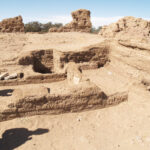

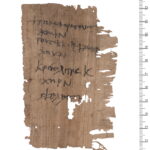
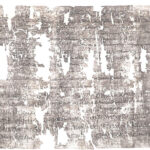
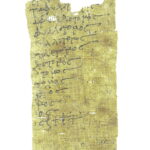
 Json data
Json data